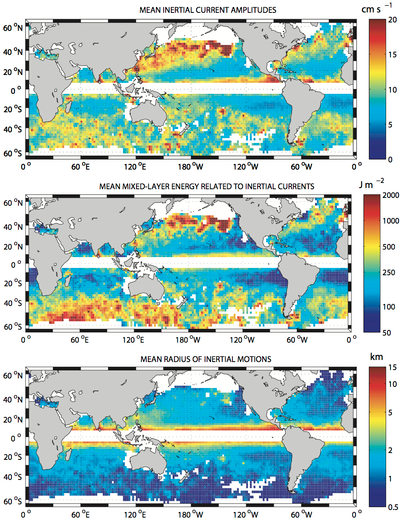Climatology of near-inertial currents
Global climatology of near-inertial current characteristics from satellite-tracked drifters. Data analyzed: 8500 near-surface satellite-tracked drifter trajectories with drogues attached at 15 m depth, available from July 1999 to December 2006.

Data analyzed
8500 near-surface satellite-tracked drifter trajectories with drogues attached at 15 m depth, available from July 1999 to December 2006.
Brief Description
This climatology provides the mean near-inertial current characteristics at annual and seasonal scales over the world ocean. Gridded fields include near-inertial current amplitudes and their associated radius as well as the inertial horizontal kinetic energy trapped in the mixed-layer.
In general, the Southern Ocean and the western North Pacific and Atlantic oceans are the most energetic in the near-inertial frequency band, whereas weaker inertial activity is observed in the subtropical and eastern boundary regions. In every ocean basin, inertial activity is higher during fall and winter, associated with maximum storms activity and deeper mixed-layers.
Dataset
- Temporal resolution: Annual and Seasonal (averaged over JFM-AMJ-JAS-OND)
- Spatial resolution: 2°×2°
- Longitude range: 180°W-180°E
- Latitude range: 65°S-65°N
- Units: cm s-1 for velocity, km for radius, J m-2 for kinetic energy
Obtaining data
This dataset can be used freely for any scientific applications provided that (i) the paper listed below is cited and (ii) CTOH is acknowledged. To obtain data, please use the Global climatology extraction Form.
References
More information about this product and its scientific application can be found in:
- Chaigneau, A., O. Pizarro, and W. Rojas (2008), Global climatology of near-inertial current characteristics from Lagrangian observations, Geophys. Res. Lett., 35, L13603, doi:10.1029/2008GL034060.
Warning:
- Dear user, please be aware that this is a research-grade product. Unexpected behaviour and/or values could be found. If this is the case please help us improve this product by providing us your feedback. Thank you.
- Cher utilisateur, ceci est un produit de qualité recherche, il n'est donc pas exclu de trouver des données aberrantes. Si cela se produisait, faîtes nous part de votre retour afin de nous aider à améliorer le produit. Merci.




